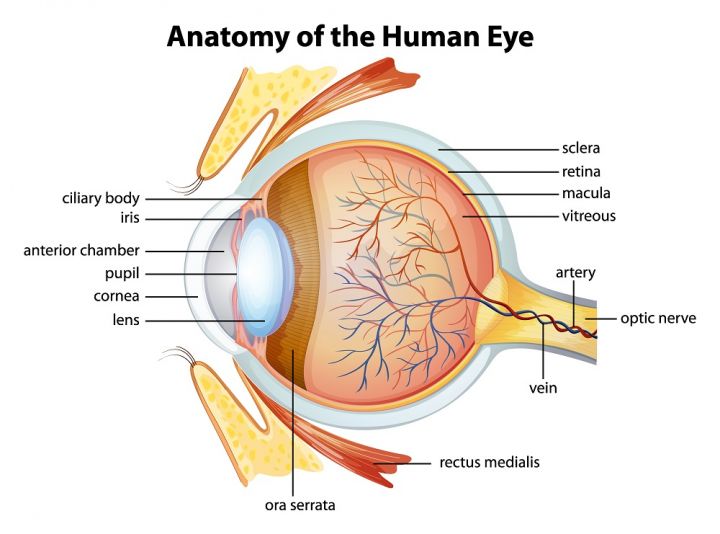How do we see?
Our vision begins with the entry of rays of light into the eye through the cornea, the first transparent tissue. Then, the rays pass through the pupil, this round opening in the center of the iris, the colored part of the eye. The pupil varies in size according to the amount of light that enters the eyes. The rays then pass through the lens which, by modifying its shape, focuses the rays according to the object being looked at: it is the focus of the eye. Finally, the light reaches the retina and its energy excites the cells, creating a nerve impulse that then travels through the optic nerve to the brain for the interpretation of what we see.
Visual acuity
It's the ability to discriminate the details. It is measured with the known test of the charter of letters. The results are generally 6 (6/6, metric system) or 20 (20/20, English system). Thus, a visual acuity of 6/12 (or 20/40) means that you have to approach 6 meters (or 20 feet) to see something normally seen at 12 meters (40 feet). This measurement indicates your vision ability.

Myopia
It is the visual problem created by the focusing of the image in front of the retina which makes the images become confused in far vision, but can remain clear in near vision. Squinting to reduce blurred vision is a common sign of myopia.
Farsightedness
This is the visual problem created by focusing the image behind the retina and causing the eye to make an effort to see from far and near, sometimes creating eye strain or blurred images at both distances. The common symptoms are the difficulty of concentrating and maintaining a clear vision for reading and writing, fatigue or headaches.
Astigmatism
This visual problem is created by a defect in the curvature of the cornea and / or the lens that makes the images blurred or distorted at all distances. Astigmatism can cause headaches, eye discomfort and visual fatigue, which vary with the degree of astigmatism.
Presbyopia
Over time, the lens loses its elasticity and ability to focus the images perceived at a short distance. Individuals in their forties often notice a gradual decrease in focus during reading. We must then read further than the normal distance. The common symptoms of presbyopia are blurred vision, headache, visual fatigue and difficulty working in near vision.
Strabismus
Strabismus is the visual condition where both eyes are not properly aligned together. In some cases, one eye is fixed while the other rotates either outward ( exotropy), inward (esotropia), or in the vertical. Strabismus usually appears in infancy, but sometimes later, depending on the cause. Treatment may require wearing glasses, exercises or possibly surgery.
Amblyopia
Synonymous with lazy eye, amblyopia is the visual condition where vision is reduced in one or both eyes even if an optical correction is worn. Amblyopia often accompanies strabismus or a unilateral vision defect that is not corrected in time. Glasses and exercises can improve it.
Glaucoma
Glaucoma is an eye disease that causes slow, progressive destruction of the optic nerve. This disease can be caused by too much liquid (aqueous humor) produced in the eye, by poor evacuation of this liquid or by poor blood supply to the optic nerve secondary to inadequate intraocular pressure. Not diagnosed or treated, this disease can cause blindness.
Cataracts
With age, as a result of shock, drug side effects or (UV) radiation, the lens gradually becomes opaque and causes a decrease in vision. Cataracts can also cause halos, dazzle and discomfort in the sun. The only treatment is by surgery.
Macular degeneration
Macular degeneration
The macula is the area in your eye where the vision is the most accurate. 25% of people over 65 are subject to drying out of this area, causing a gradual decrease in vision. In rare cases, bleeding from the fundus may occur. Frequent control examinations and taking antioxidant tablets are part of the required treatments even if the condition is incurable in the long term.
Flying flies or floating bodies
They are often particles of proteins or other natural materials floating in the internal fluid of the eye. If these particles are big enough, they cause shadows and we have the impression to see them float before our eyes. They are also called "floating bodies". They can also be caused by a deterioration of the ocular fluid (vitreous). If they are accompanied by flashes of light, they can be signs of damage to the retina. At all times, flies and / or flashes should be subject to detailed examination of the retina. Ask your optometrist.
Preventive tips:
- See your optometrist regularly. With the years, your eyes change and a regular eye examination can detect potential problems before they become more serious. Your optometrist will advise you on the frequency of your exams.
- Use adequate visual correction for your hobbies, sports and work. Discuss your activities with your optometrist.
- Do not use another person's glasses. Each visual prescription is unique to everyone.
- Only use premium lenses. Distortions can cause you visual damage.
See your family optometrist!
(Source : Association des Optométristes du Québec)
